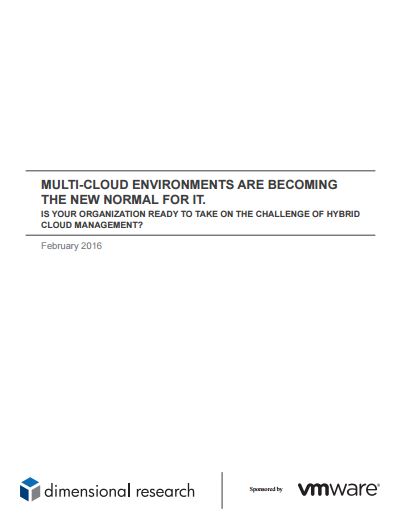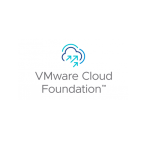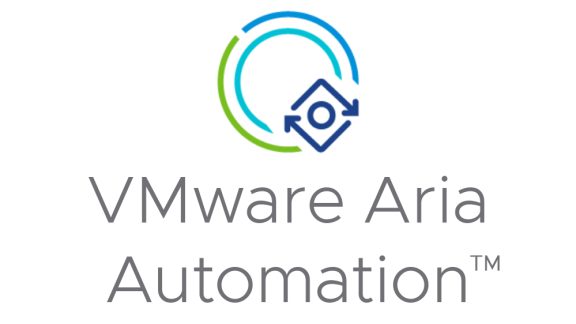Recently VMware commissioned Dimensional Research, a market research firm, to investigate how companies were adopting both private and public clouds. The full report can be found here. Besides looking at adoption patterns the research also examined the benefits companies expected to receive from their cloud implementations and asked several questions about where companies were today in terms of building the kind of comprehensive automation necessary to be successful at managing a multi-cloud environment.
Multi-Cloud Report from Dimensional Research
The report finds a large majority of companies are already operationalizing a multi-cloud strategy. The report also found that in order to reap the benefits of a multi-cloud solution, participants of this survey recognized that cloud automation was critical. The majority of companies surveyed want sophisticated automation that will enable the rapid delivery of both infrastructure and application services. Nearly three-quarters of those surveyed stated their company plans to offer self-service to end-users as well. However, the same survey found that most respondents today are still leveraging scripts and task-based automation to deliver private cloud services , an approach that has proven to be insufficient to deliver an end user experience equivalent to what users receive when they use a public cloud service.
vRealize Suite: Talking to Customers
Last summer I spent a good chunk of time talking with VMware customers to see what they were actually doing in the area of automation. What I found was that most enterprises that have an automation platform like vRealize Suite are first and foremost starting their cloud journey with a focus on automating the IT tasks associated with provisioning what I call “production ready” infrastructure. That is provisioning compute with the appropriate, storage, network and security elements.
The initial goal for these organizations is to just to cut out the many hand-offs that occur between IT teams working to provision production ready infrastructure to a line of business partner of some type. The person requesting infrastructure can be requesting it for any number or reasons. They may be looking for a machine for development or they may be looking to expand capacity for an existing production application.
Cloud: The Service Desk approach
Before implementing a comprehensive automation solution, most of these organizations had a 100% service desk ticket driven process. The initial request was raised through the service desk and then multiple teams were sequentially routed that ticket and each team contributed something to the build of the infrastructure. One organization I know of inventoried the number of steps involved in provisioning infrastructure in this manner and found that there were greater than 100 unique steps involved. Using this approach, ultimately production ready infrastructure is produced but it generally takes multiple weeks to accomplish the task.
Even with the somewhat limited focus of simply speeding up the delivery of production ready infrastructure, customers that embrace a fully automated approach can still reap huge benefits. Before the adoption of comprehensive automation solution most of these IT teams took on average between 3 and 4 weeks to accomplish the delivery of production ready infrastructure. After they deployed a more complete solution they generally were able to reduce the time it takes to provision the same infrastructure to less than a day and in many cases less than an hour.
Most of the organizations I talked with are not yet using any form of end user self-service to fulfill requests though consistent with the Dimensional Research survey, I found that it is definitely on their roadmaps. Nor are most of these IT teams actually provisioning complete application stacks even though the same technology could be leveraged to accomplish that as well. The truth is that implementing end user self-service and provisioning complete applications offers additional process and organizational challenges that many of these companies were not yet ready to take on.
Having said this, as the Dimensional Research study pointed out, providing end users self-service and delivering complete applications to line of business partners remains a strong aspiration for the majority of these companies. It will take some time but enabling self-service and delivering complete application stacks is attainable. I know of multiple companies that are being successful with these objectives already. You have to start somewhere and getting the process down to automate and speed up the delivery of infrastructure is a very good first step.
Learn More About How VMware Can Help Teams Accelerate IT Service Delivery
VMware’s vRealize Suite is an Enterprise-ready, cloud management platform that delivers the industry’s most complete solution for managing a heterogeneous, hybrid cloud. vRealize Suite supports companies addressing cloud management requirements across day one service delivery and day two operations for compute, storage, network and application level resources. The easiest and quickest way to learn more about VMware Cloud Management Platform solutions is to visit us online at VMware vRealize Suite.









